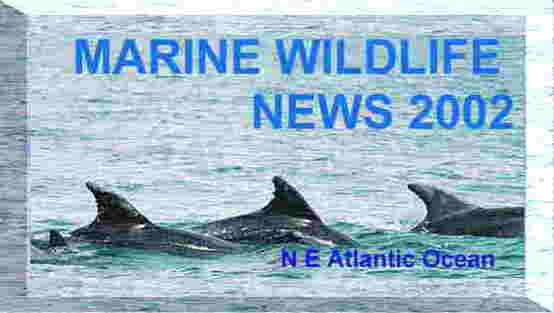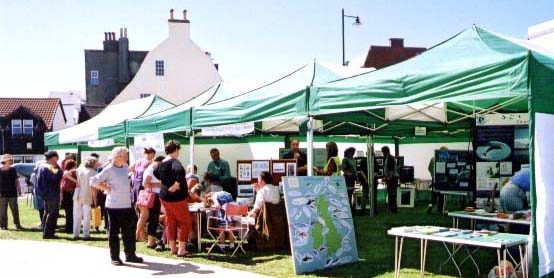
|
|
|
|
|
(BMLSS *** Site) |
|
|
|
Norwegian Marine*** |
|
L-I-N-K-S to Other Sites (Click on Text) |
|
How to Join |
|
|
|
|
|
Recommended Sites |
|
|
|
|
|
|

Monthly Marine News Bulletin |
|
Marine Nature Conservation Review Survey Database |
|
|
 |
|
|
|
|
|
|
.
Reports of marine wildlife from all around the British Isles, with pollution incidents and conservation initiatives as they affect the fauna and flora of the NE Atlantic Ocean.
on Microsoft Internet Explorer (best) or Netscape
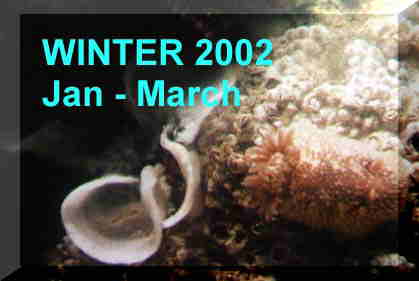 |
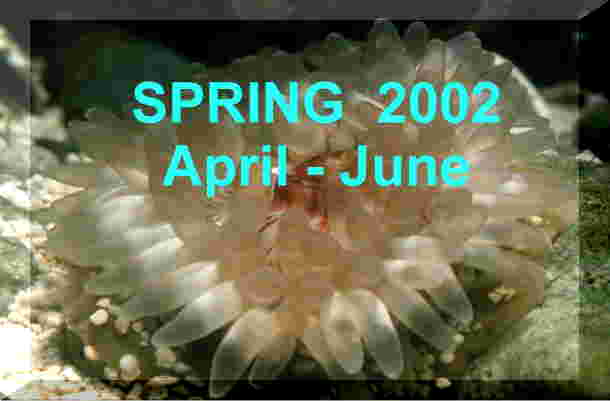 |
 |
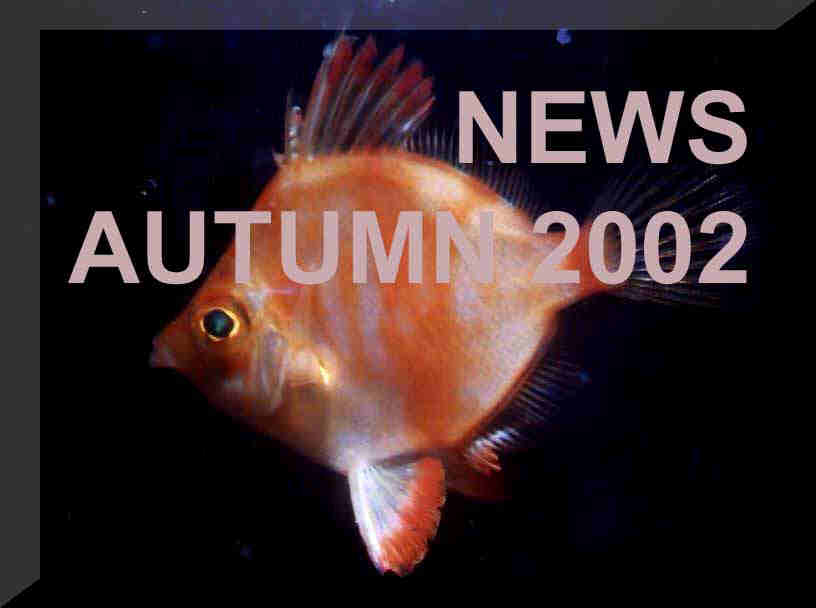 |
- LATEST
NEWS
 26
June 2002
26
June 2002
A
jellyfish
was discovered alive in a rockpool on Worm's
Head, the "wurm"-shaped rock island connected at low tide by a causeway
to the western end of the Gower peninsular at the southern end of Rhossili
Bay in south Wales. By comparing the size of the periwinkle
in the pool the viewer can see the size is about 100 mm in diameter. The
jellyfish has been identified as the Blue
Jellyfish, Cyanea lamarckii. Inverted the jellyfish was
white underneath. It quickly righted itself.
Link
to a higher resolution image
Amongst
the mixed rocks, another much larger jellyfish was also washed up dead.
Link
to a higher resolution image
BMLSS Cnidaria
Cnidarian Mailing List
22
June 2002
The
Phocine
Distemper Virus has been identified as
the cause of a new increased total of 461 Common
Seals,
Phoca vitulina, carcasses
tested in Denmark, with a further 150 in Sweden and dead seals also recovered
on the shores of the Netherlands.
First
Report for 2002
Ananova
News Report
BMLSS
Seals
Any
dead seals should be reported to the marine mammals stranding telephone
line
maintained
by the Natural History Museum on 0207 942 5155 (24 hr answerphone).
21
June 2002
Summer
Solstice 2:11 pm.
20
June 2002
A Cuvier's
Beaked Whale, Ziphius cavirostris,
was stranded alive on the south end of the beach at Ostend, Happisburgh,
Norfolk, eastern England. A rescue attempt was made in the evening by the
Norfolk coastguard and RSPCA, but sadly the whale beached and died overnight.
The
stranded whale is an adult male, with two protruding teeth, pale head and
beak and shows extensive scarring over the dorsal surface, particularly
between the blow hole and dorsal fin. This stranding is unusual for a deep
water whale which on the rare occasions when they are washed up on western
British coasts they are in a badly decomposed condition.
BMLSS Cetacea
An estimated 30 plus Basking Sharks, Cetorhinus maximus, were seen this morning between Longships and Brisons off the south-west of Cornwall.
19
June 2002
Goose
Barnacles, Lepas anatifera, are
washed up on a plank at Borth-y-Gêst, near Portmadoc, north Wales
(Tremadoc Bay, north bit of Cardigan Bay), and these attracted the curiosity
of the public.
15
June 2002
An
extremely unusual record of a live stranding of a female Atlantic White-sided
Dolphin, Lagenorhynchus acutus,
on the sandy beach outside of Newhaven harbour, East Sussex occurred in
the early evening. The tail muscle was in such poor condition that the
experts on site decided on euthanasia. They were also able to confirm the
identity of this deep water northern species that is a rare discovery in
the English Channel. There was no hourglass pattern like a Common
Dolphin with the yellow zone behind the dorsal
fin and the distinctive patterns could be seen clearly. The
last
English record on the BMLSS records occurred of a specimen washed up
dead on the north Devon coast in 2000. This species is seen occasionally
around the Shetland Isles but other reports are exiguous.
Bionomics of the Atlantic White-sided Dolphin in the NE Atlantic (Link)
Shetland Isles (map)
Bionomics Link (for CD-ROM only)
June
2002
An
American
Lobster,
Homarus
americanus, was discovered captured by a fishing vessel on a boat out
of Selsey, West Sussex. A few specimens have been caught before in the
approaches to Southampton Water.
12
June 2002
A
crab fisherman found a specimen of the pelagic crab called the 'Sargassum'
or 'Gulf Weed Crab,' Planes minutus
on a float, which was covered in barnacles.
The float was found in the Big Russel between Herm and Sark to the east
of Guernsey, Channel Islands. This crab is rarely recorded from the English
Channel.
BMLSS Crustacea
> 10
June 2002
The
bodies of more than 310 Common Seals,
Phoca
vitulina, have been washed up on the Danish and Swedish coasts, raising
fears of an epidemic of the highly contagious and usually fatal
Phocine
Distemper Virus. The origin of the the
outbreak on the Kattegat and Skagerrak coast of Denmark and south Sweden
prior to the breeding season is the same place as the 1988 epidemic which
quickly spread to the east coast of England and killed about 2000 seals
in the Wash (60% of the population).
The virus causes pregnant seals to abort their pups, pneumonia and nervous system abnormalities including convulsions.
BBC
Norfolk Report
BBC
National News Report
BMLSS
Seals
8 June
2002
Official
WORLD
OCEANS DAY
World Oceans Day was first declared as 8th June at the Earth Summit in Rio de Janeiro in 1992. Events will occur all around the world on and around this day.
World Oceans Day offers the opportunity for people in many parts of Britain and around the world to increase their understanding of the marine environment and wildlife of the oceans.
7 June
2002
A
rarely discovered Sowerby's
Beaked Whale, Mesoplodon bidens, was
washed up dead on Praa Sands, Mount's Bay, Cornwall. Nick
Tregenza and David Ball identified it as Sowerby's
Beaked Whale, an adult female, about 4 metres in length.
The
freshly dead mammal was hauled with some difficulty above the high tide
to enable the Natural History Museum to take samples which will become
part of the scientific collection. This only the fourth record of this
whale from Cornwall. One of the previous records was of a live specimen
that was rescued.
This whale is rarely discovered and rarely seen alive long enough for a positive identification because it usually inhabits deep waters, usually seen breaching the surface of the sea over the 1000 metre isobath. Rarely is it possible to differentiate which species of beaked whale from these brief unexpected encounters, but Sowerby's is the commonest of the four species of ziphids (=Ziphiidae) that live regularly in the seas around the British Isles.
Marine Mammals of the English Channel Smart Group
3
June 2002
The
Dutch water-police spotted a Sperm Whale,
Physeter
catodon (pic)
(pic2)
of about 15 metres in the Westerschelde (a large estuary that finally ends
up in Antwerp). The animal was swimming the wrong way and surfaced in the
"Buitenhaven" and later the "Sloehaven" of Vlissingen.
Thanks
to a combined rescue operation of the EHBZ-team Zeeland and the EHBZ-team
Belgium the animal was guided trough the fairway to deeper waters. About
midnight the Sperm Whale was spotted close to Zeebrugge (Belgium).
Source
and Map (Zeehondencreche [Netherlands Seal Rehabilitation and Research
Centre] Pieterburen)
deeper water. If they change direction and arrive in the shallow waters north of Belgium and the Netherlands, scientists believe that the navigation system of these animals is disturbed, as they are used to navigating in deeper oceanic waters. There is also little food for Sperm Whales in this part of the North Sea, so they end up stressed and malnourished. Stranded animals on the Belgian and Dutch shores can seldom be refloated.
Cetacean Research (& Rescue) Unit (CRRU)
Reports via the Marine Wildlife of the North-east Atlantic Ocean Group
Cetacean Rehabilitation in Netherlands and Denmark
BMLSS Cetacea
3
June 2002
Between
Chanonry Point and Fort George, near Inverness, Scotland, two Bottle-nosed
Dolphins,Tursiops
truncatus, attacked and killed a young Harbour
Porpoise, Phocoena phocoena. The
sustained attack lasted from around 14.30 until 15.00 hours. The tide was
just beginning to rise when the two dolphins, over on the Ardersier side
of the Chanonry narrows began to chase and catapult a juvenile porpoise
out of the water. The body of the
porpoise
floated past Chanonry towards Inverness, where the dolphins eventually
lost interest in it and began to forage for food in the tidal current.
1 June
2002
Adur
WORLD
OCEANS DAY Exhibition at Coronation
Green, Shoreham-by-Sea.
Adur was one of the leaders in the United Kingdom when it presented an Exhibition celebrating the official World Oceans Day. The event took place on Saturday 1 June 2002in Shoreham-by-Sea, on Coronation Green (TQ 216050), adjacent to the footbridge over the River Adur, with the start of the Adur Festival.
CLICK ON THE IMAGE FOR MORE INFORMATION
Adur
World Oceans Day Picture Portfolio 2002 (by
Ray Hamblett)
Adur
World Oceans Day 2002 Programme of Events
Adur
World Oceans Day 2001 Report
Adur
World Oceans Day Picture Portfolio
World
Oceans Day Smart Group
27
May 2002
"Millions"
of Velella velella, the By-the
Wind Sailor were discovered by Nick
Darke on Porthcothan
Beach, Cornwall. They are freshly dead, the float having the animals or
at least fragments of the soft tissue, still present. They are probably
all along the north coast, especially at Perranporth, so I will be interested
to have an idea of the maximum density per sq. metre. The last really big
incursion was in June/July 1981 when
Rennie
Bere counted 150 to 200 per sq. metre, as
they came in on the tide (i.e. not heaped up in catchment areas) and he
estimated 100,000 for the stretch of shore at Bude.
Thousands of Velella are washed up on the north Devon strandline from Westward Ho!, Croyde and Woolacombe.
via the Marine Wildlife of the North-east Atlantic Ocean Group
 On
30
May 2002 thousands of Velella
velella were also washed up along
the tide line on the beach at Nicholston Burrows on the Gower peninsular,
South Wales.
On
30
May 2002 thousands of Velella
velella were also washed up along
the tide line on the beach at Nicholston Burrows on the Gower peninsular,
South Wales.
On 15-16 June 2002, smaller numbers of Velella were washed up here on the Isle of Cumbrae. This appears to be the first record in the Firth of Clyde (which has been fairly well studied since the 1880s at least!). 13 June 2002 found thousands of Velella were washing in on Kilmory Bay, Sound of Jura, Argyll, Scotland. There was a lot of foam along the tideline at the time and they were quite fresh. This is a south-west facing bay inshore of Islay and Jura in the western islands and the furthest north record for 2002.
Scottish Association for Marine Science (SAMS), Dunstaffnage Marine Laboratory
Large numbers of dead Velella along strandline of sandy beach at Kilmore Quay (SE Ireland). Estimated to be in excess of 300 Velella per metre of strandline for about 50 metres (= 15000). They were a bit dried out so must have been there for a few days.
The first dead Velella is washed up on a Sussex beach at Bognor rocks. This is the most easterly record so far up the English Channel.
Bionomics of Velella (notes)
May
2002
A
Common
Octopus,
Octopus
vulgaris, was caught three quarters of a mile at Chapel Point off
Mevagissey, Cornwall, and presented to Mevagissey
Harbour Marine Aquarium.
A
Boar
Fish,
Capros aper,
was also caught close inshore in a Pilchard net and it is one of two of
these attractive fish on display in the aquarium.
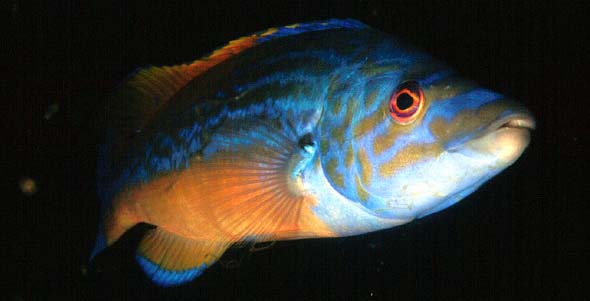
c.
12 May 2002
A
male Cuckoo Wrasse,
Labrus
bimaculatus, caught by a boat angler off Littlehampton is an unusual
record from off the Sussex coast. There is a rocky dive site known as the
Waldrons where these wrasse occur regularly.
9 May
2002
A
pod of six Killer Whales,
Orcinus
orca, are seen from the Fetlar ferry in the Bluemull ‘triangle’. (Fetlar
is an island in the north-east of the Shetland Isles.) They were probably
the same pod that was seen in March.
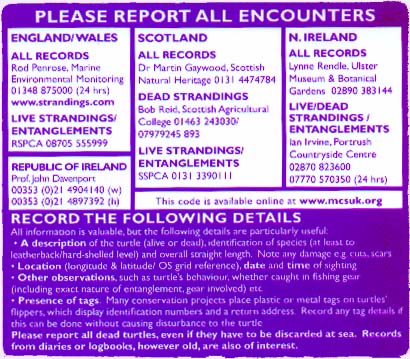 9
May 2002
9
May 2002
With the swarms of jellyfish it is does not come as a surprise that a predatory Leatherback Turtle, Dermochelys coriacea, was seen by Ian and Joy Olford 50 metres from the shore off Polruan, Cornwall (SX 125 511). The jellyfish Rhizostoma octopus was seen nearby and jellyfish are the principal diet of these turtles.
EuroTurtle
The Marine Conservation Society have produced a laminated Turtle Advice Sheet (endorsed by DEFRA). The guide contains reports numbers and advice.
Turtle Report Numbers
MCS Turtles
7-9
May 2002
Whilst
on Colin Speedie's Basking Shark survey last
week we were almost continually among the jellyfish Rhizostoma
octopus (from Lands End to Fowey, Cornwall), some areas had
particularly dense aggregations of them.
There have been reports of jellyfishes from the Cornish and Devon coasts, including Rhizostoma octopus at 50 cm diameter with a purple rim to the bell stranded near the swimming pool at Devil's Point (Western Kings) on the Plymouth foreshore on 7 May. Richard White (of Devon Wildlife Trust) saw lots of Rhizostoma at Church Cove on the Lizard, Cornwall, on 5 May.
A report arrived via Brixham Coastguard from a member of the public; that a large jellyfish (one metre across) had been found in the Imperial Recreation Ground in Exmouth, Devon, on 6 May 2002.
(Several reports.)
By 1 June 2002 the Rhizostoma octopus had reached as far east as Sussex with one specimen of nearly a metre in diameter washed up at Shoreham Beach.
23 June 2002
At least 15 Rhizostoma octopus jellyfish, ranging in size between about 10 cm to 60 cm in size were washed up on Studland beach in Dorset.
2 May
2002
A
baby Harbour Porpoise,
Phocoena
phocoena, is washed up alive on Pagham beach, Sussex, but dies shortly
afterwards.
12
April 2002
A
Sleepy
Crab, Dromia personata,
was brought in by a Mevagissey (south Cornwall) inshore fisherman caught
in shallow water. This was the first time this crab had been seen by the
fisherman of 16 years experience. It is a rather distinctive crab the shape
and size of a tennis ball and the light brown crab is covered in hairs
which gives it a velvety appearance. As befits its common name it is not
very active in the Mevagissey Harbour
Aquarium. One of its distinguishing characters that enabled me
(Andy Horton) to make the identification from a
verbal description are the claws on each of the legs. This crab is rare
throughout its range in British seas, found in the English Channel and
as far north as Cardigan Bay on the west coast.
 Mevagissey
Aquarium is a Grade I Listed building and its tanks are renewed with fresh
seawater twice daily which makes it an ideal environment for keeping crabs
and other large crustaceans which appreciate
regular water changes of this frequency. Mevagissey Aquarium houses the
Comber,
Serranus
cabrilla, caught in June 1996, and an attractive Boar Fish,
Capros
aper.
Mevagissey
Aquarium is a Grade I Listed building and its tanks are renewed with fresh
seawater twice daily which makes it an ideal environment for keeping crabs
and other large crustaceans which appreciate
regular water changes of this frequency. Mevagissey Aquarium houses the
Comber,
Serranus
cabrilla, caught in June 1996, and an attractive Boar Fish,
Capros
aper.
Marlin Information Page
BMLSS Intertidal Crabs
7 April
2002
Roger
Whear reports at least 150 Common
Dolphins, Delphinus delphis, three miles off Coverack, Cornwall.
They covered an acre of sea, and many were leaping around his boat. He
also saw one Basking Shark, Cetorhinus
maximus, maybe
the first of this year.
The
toll of dead cetaceans on Cornish shores this
year is 114 so far.
1
April 2002
An
unusual discovery over Easter was three Snapping
Prawns, Alpheus macrocheles,
under boulders in Kimmeridge Bay, Dorset. These are listed as very
scarce in Hayward and Ryland, though I suspect
"rarely seen" would be a better description. They were about 30 mm
long, a lovely yellowy-orange colour and two were berried.
Crustacean News Reports
30
March 2002
The
small patch of loose tunicate-covered flint rocks with small bits of chalk
at Lancing beach, Sussex, proved
unusually rich in small rockpool life at the
very low tide (TQ
018 034). The
discoveries included a Pimplet
Anemone, Anthopleura ballii, another anemone
species that has never been recorded this far east before.
23
- 24 March 2002
A
pod of between 30 and 40 Pilot
Whales,
Globicephala melas, became stranded, or nearly stranded,
at near Camp in North in Tralee Bay, County Kerry, Ireland, and were prevented
from beaching and helped back out to sea. 18 of these whales (actually
dolphins with a bottle-shaped head) perished, but many were coaxed back
into the sea on the first day. On the following day, 10 to 12 whales were
spotted the shallow water of Fenit Harbour, but they did not become beached
and the Fenit lifeboatmen were able to escort them back into deeper water.
BMLSS Cetaceans
22
March 2002
A
pod of six Killer Whales,
Orcinus
orca, are seen from the Fetlar ferry in the Shetland Isles. (Fetlar
is an island in the north-east of the Shetlands.)
21
March 2002
About
twenty dead Lesser Octopuses, Eledone cirrhosa, were
scattered over a stretch of about 200 metres of Killiney beach, Co. Kerry,
Ireland.
20
March 2002
Vernal
Equinox at 19:03 GMT (UT).
FOR EARLIER REPORTS CLICK ON THE BUTTON BELOW

The Marine Wildlife of the NE Atlantic Forum.
PLEASE JOIN

MARINE WILDLIFE of the NE ATLANTIC EFORUM PAGE (LINK TO)
Shetland Wildlife
News & Information on the Wildlife of Shetland http://www.wildlife.shetland.co.uk/Cornish Wildlife
Vince Smith's Cornish Mailing List
Send a message to the list at: CornishWildlife@onelist.com
News 2000
News 1999
|
Use these links if your are familiar with the scientific classifications of marine life |
The BMLSS (England) site commenced on 1 January 1997.
|
|
 |
 |
Andy Horton, Webmaster
|
|
|
|
|
|
Membership Form |
News 2000 |
